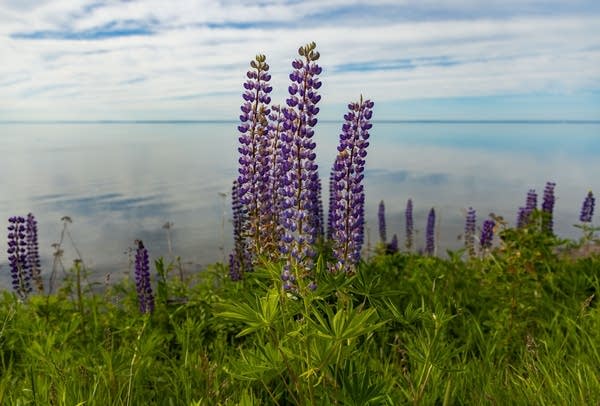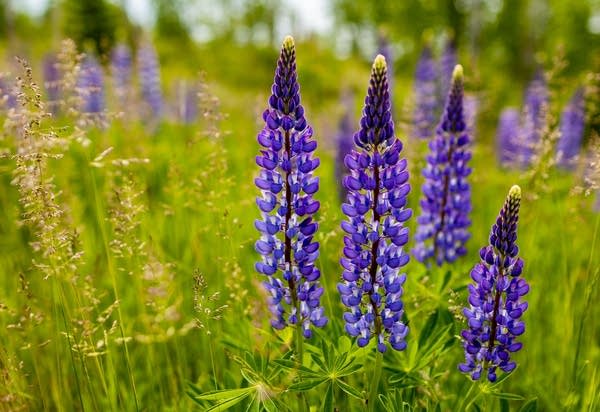Invasive lupine, a lovely lightning rod on Minnesota's North Shore

Go Deeper.
Create an account or log in to save stories.
Like this?
Thanks for liking this story! We have added it to a list of your favorite stories.
Every year, in early summer, fields of lupine erupt in a cornucopia of color along the North Shore of Lake Superior, in different shades of purple and pink, blue and white.
Photographers adore the tall, showy, vibrant wildflowers. Lupine images sprout on Facebook this time of year.
Yet those pictures are often accompanied by critical comments, pointing out that the lupine that now spreads across northeastern Minnesota is not native to the state.
Indeed, lupine presents a lovely paradox, a beautiful plant that potentially damages the region’s ecosystem.
Turn Up Your Support
MPR News helps you turn down the noise and build shared understanding. Turn up your support for this public resource and keep trusted journalism accessible to all.
“It’s a double-edged sword,” conceded Beth Miller, a retired teacher and self-described “nature nerd” who’s also a photographer and loves to capture images of lupine.
"There are so many different color combinations,” she said, while looking out on a large patch of lupine next to some railroad tracks just up the shore from Duluth.
“So you got one there that's blue with a white center and you got another layer that's blue with a pink center."

But she's also conflicted about them. This species of lupine, called Bigleaf or large-leaved lupine, is from the West Coast. Gardeners initially brought it to the Midwest. Now it's found throughout the northern U.S., and over the past ten years or so, it's proliferated, especially along the North Shore of Lake Superior.
"It does choke out other wildflowers that might be growing in this ditch that are native, like this might be a habitat for Small Yellow Lady’s-slippers,” Miller said. “But they can't compete with lupine which is a more aggressive plant.”
Lately Miller has taken to posting pictures of attractive native wildflowers such as columbine. But people are passionate about lupine.
"Usually people have a pretty strong opinion about how much they like the plant,” said Superior National Forest plant ecologist Jack Greenlee.
Occasionally the Forest Service sprays patches of lupine with herbicide, so it doesn't spread into nearby areas that have been logged or treated with prescribed fire. And when they do, Greenlee said he often hears about it.
“It's like, ‘oh, this is such a pretty plant, why are you killing it?’” Greenlee says is one comment he gets a lot. Others argue it’s not doing any harm.
Greenlee uses those conversations as opportunities to educate people. Lupine can outcompete native species, Greenlee tells them, and once it gets a foothold, it sticks around.
"I don't know that I've ever changed anyone's mind,” he said. “But it's an opportunity to talk to people and at least let them hear the other side of why why we have a concern with it."
Greenlee ranks lupine as having a “moderate” ecological risk. It's not as damaging as invasive species such as buckthorn, he said. But it can spread quickly and dominate areas once it gets established. And because it has deep root systems, it’s tough to eradicate.

Brooke Haworth, a regional plant ecologist for the Minnesota Department of Natural Resources, says lupine is not creating a huge problem at this point.
It's not considered a noxious weed by the Minnesota Department of Agriculture, which manages invasive plants that have a major economic or environmental impact.
Anthony Cortilet, who supervises the noxious weed program for the Ag Department, said they have received requests to assess big-leaved lupine.
“As you can imagine, everyone has a favorite plant that they don't like. However, not all invasive plants are noxious weeds,” he said.
The DNR’s Haworth said lupine does have what she calls an “invasive tendency.”
"It will push out other native species and take up their habitat,” Haworth said. “It outcompetes them, and so it cuts down on the native species biodiversity."
That can have cascading impacts, she said. For example, native insects have adapted over time to rely on native plants, and native birds in turn rely on those native insects. Non-native plants can disrupt that chain.

There’s also a wild lupine that's native to Minnesota that the non-native plant could potentially outcompete, Haworth said.
Wild lupine is significant because the federally endangered Karner Blue butterfly relies on them for food, much like monarch butterflies are dependent upon milkweed. The non-native lupine does not provide that same benefit.
Wild lupine is most abundant in southeastern Minnesota. But the two species do overlap some in east-central Minnesota. If non-native lupine were to begin to outcompete wild lupine and replace it on the landscape, that could cause problems for the endangered Karner Blue butterfly, Haworth said.
The Minnesota DNR is actively managing lupine at state parks and trails along the North Shore. Liza McCarthy, DNR Resource Program Specialist for the parks, said crews cut it by hand or cut the heads off the flowers to prevent it from going to seed.
"In my opinion, we don't need the extra appeal of lupine. Because the natural beauty of our natural and cultural resources in state parks and trails is wonderful as it is" she said.



